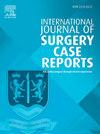Management of a complex multiligament knee injury: Simultaneous reconstruction of ACL, PCL, and both meniscal roots
IF 0.6
Q4 SURGERY
引用次数: 0
Abstract
Introduction
Multiligament knee injuries (MLKIs) can lead to severe complications like early osteoarthritis and functional loss. Meniscal root tears further increase these risks. This study reports the first documented case of simultaneous anterior cruciate ligament (ACL), posterior cruciate ligament (PCL), and dual meniscal root injuries, emphasizing the unique surgical and rehabilitative challenges involved.
Presentation of case
A 19-year-old male presented with persistent knee pain and instability seven months after a traumatic injury from a major fall. Examination revealed a range of motion of 0–120 degrees, no swelling or tenderness, but a positive recurvatum over 10 degrees, indicating significant instability. Lachman's, McMurray's, pivot shift, and both anterior and posterior drawer tests were positive.
Discussion
The radiography of the right knee revealed no fractures. The MRI confirmed injuries to the ACL, PCL, and the posterior roots of both the lateral and medial menisci. The patient received surgical intervention. Grafts were obtained: the peroneus longus tendon autograft for posterior cruciate ligament reconstruction and a hamstring autograft for anterior cruciate ligament reconstruction. The ACL and PCL reconstructions were subsequently performed utilizing an all-inside technique, and both posterior roots of the lateral and medial menisci were repaired. Postoperative care included knee immobilization and a progressive rehabilitation program.
Conclusion
Effective management of multiple ligament knee injuries necessitates a comprehensive approach, including precise identification and treatment of all torn ligaments, accurate graft placement, and robust fixation. Simultaneous reconstruction reduces hospital stays, anaesthesia exposure, and surgical risks while streamlining rehabilitation, enabling quicker patient recovery and improved outcomes.
求助全文
约1分钟内获得全文
求助全文
来源期刊
CiteScore
1.10
自引率
0.00%
发文量
1116
审稿时长
46 days

 求助内容:
求助内容: 应助结果提醒方式:
应助结果提醒方式:


